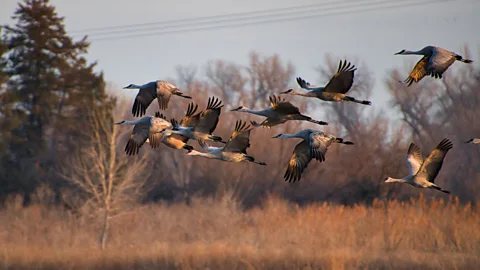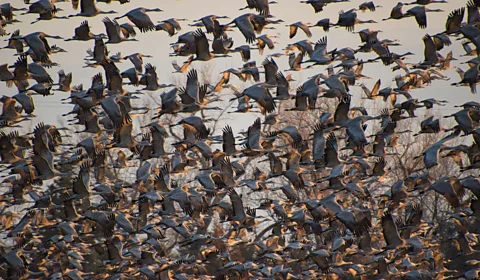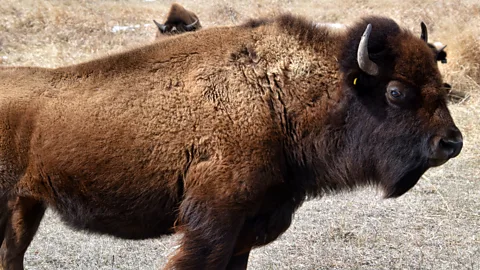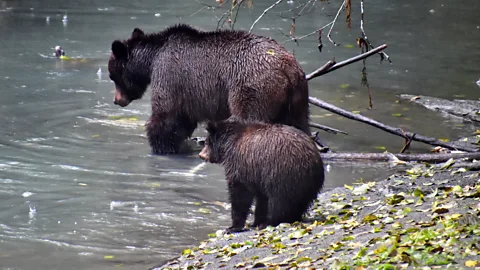The ancient practice reviving North America's birds, bears and berries
 Brandon Withrow
Brandon WithrowThe destruction a fire brings can be crucial for certain species to thrive. Meet the conservationists reviving the ancient art of "good fire".
Every spring, more than 600,000 sandhill cranes migrate through Nebraska following the Platte River. Having arrived from as far as the southern US and Mexico, the birds linger in a location for weeks, fattening themselves during the day in the fields to prepare for their journey as far north as Siberia. They rise with the sun, pull their red-capped heads out from under their gray wings, and start their unmistakable vocalisations — a deafeningly loud bugling sound that churns repeatedly in their throats.
Then something amazing happens: they take flight in waves of the tens of thousands, leaving to feed in nearby fields before returning to the river at night.
The spectacular show is the most important tourism draw for cities in the area, with an economic impact of around $14.3m annually. Birders migrate annually by the thousands to the Iain Nicolson Audubon Center at Rowe Sanctuary in Kearney or the Crane Trust outside of Grand Island, Nebraska. But this precious stopover site has come under threat, like other grasslands around the world, from a number of factors including agriculture and invasive plant species.
To preserve it, conservationists are reviving an ancient but long-suppressed land management method: controlled burns.
Also known as "prescribed burns" or "cultural fires", these intentionally started, controlled fires have received growing attention in recent years, as a way to clear dry undergrowth that can build up and fuel huge wildfires. One 2024 review suggests that prescribed burning can reduce the severity of wildfires between 62% and 72% relative to untreated areas. However, the idea of prescribed burns is not new. Indigenous communities long used "cultural fires" to remove old grass and support new growth. In addition, controlled fires may also help create a healthy ecosystem for cranes and other species by creating open habitats.
 Cody Wagner
Cody Wagner"Grasslands are one of the most endangered ecosystems globally, with research showing a 60% decrease in grassland biodiversity since the 1970s," says Amanda Hefner, education manager at Audubon's Rowe Sanctuary. "So the best way we can make sure that the grasslands stay grasslands, is by making sure that we're using tools to keep it in that habitat — tools like prescribed fires."
This allows for "nutrient cycling", adds Hefner. Wildfires are often highly intense burns that strip the land of nutrients, while low intensity, prescribed burns can clear fuel leaving nitrogen, minerals found in ash, and partially burned, decomposing biological material, increasing nutrients in the soil soon after a burn. With the litter being cleared, there is now room for new, more nutritional growth.
Prescribed burns involve planning specific patches to set on fire. Those patches might be near firebreaks, like a road, or burn specialists might mow breaks around the burn area, which removes litter and dry grasses that could help a fire spread. They will also spray it with water to keep the fire from spreading to the break. They must take into consideration things like humidity, wind direction and where they want the fire to be pushed by that wind. If they've cut out a U-shape, for example, they move the fire forward until the section is completely burned. The team works together to keep it under control. Patches are usually relatively small, and timing depends on the last time they were burned, whether grazing animals are willing to eat there, which invasive species are taking over and how the area is being used by wildlife.
The fires are part of an effort to restore the cranes' natural habitat, which conservationists say used to be shaped through an intricate interplay of natural cycles and indigenous communities' intervention. Human impact has entirely transformed that original habitat, meaning that a full return to the original conditions is impossible, and making this form of partial restoration crucial.
 Brandon Withrow
Brandon WithrowA crane paradise lost
In its original shape, the once wide, but relatively shallow Platte River provided an open space for the cranes to roost, while also keeping an eye on predators. These four-to-five-foot tall birds with wingspans of six-to-seven feet found abundant plants and insects to eat on the Nebraskan prairies. Lightning strikes brought occasional wildfires, which cleared out dead material and refreshed native plant life.
"It's estimated that, especially in the central Great Plains where Nebraska is, there was somewhere between a five and seven year fire return interval," says Josh Wiese, range manager for the Crane Trust. "An acre would have burned every five to seven years." These could have been wildfires caused by lightning strikes or even indigenous cultural fires, he noted.
"What fire does is clear off that vegetation," says Wiese. "Specifically for cranes, that allows them to get their beaks down into the dirt and pick out tubers," as well as earthworms and different invertebrates.
Indigenous communities understood the importance of fire for a healthy habitat for certain birds and other species, says Amy Cardinal Christensen, a policy advisor for the indigenous Leadership Initiative and co-host of the podcast, Good Fire.
"Indigenous people were on the land and would have seen those lightning fires," and replicated them with controlled burns, says Christensen. Depending on the nation, she says, there were specific experts – fire chiefs, grandmothers, or families – with the knowledge and the responsibility for cultural fires. These cultural fires prevented the meadows from becoming forest again, and cleared land in a way that would make it easier to hunt rabbits, weasels and even bison, she says.
Christensen is Métis and raised in northern Alberta, Canada. She has worked as a research scientist with the Canadian Forest Service and is an indigenous fire specialist for the National Fire Management Division of Parks Canada. Fire has been a large part of her life. Canada, said Christensen, "got really good at fire suppression". As European settlers colonised the land in both Canada and the US, indigenous fire practices were suppressed.
 Brandon Withrow
Brandon WithrowA shrunken river
The River Platte also changed. As European settlers moved West, cities dammed up the Platte and shrank its flow and size, allowing for encroaching woody, plant-life to spread inward at the river. According to the Audubon center, human activity reduced channel widths in the Platte River by 80-90%. Nebraska's wetlands and prairies became farmland, leading to roughly 75% of those wild spaces disappearing. Without their original sources of a rounded diet, birds were left eating a dominant meal of waste grain, which is primarily corn, that is leftover in the fields from the harvest.
Even with these changes, cranes have proven to be highly resilient birds, with more than half a million arriving annually from February to early April, putting on a massive display. While the River Platte is the biggest sandhill crane migration corridor, smaller populations can be found migrating through other parts of the US, like Lodi, California, where there's even an annual festival. Thirty minutes away from Rowe at the Crane Trust, approximately 10,000 acres are protected as critical habitat for endangered whooping cranes and sandhill cranes.
Both Rowe and the Crane Trust use grazing bison or cattle along with controlled burns to maintain the open grassland and prevent shrubs from encroaching. The Crane Trust even has its own bison herd for that purpose.
"We use [burns] to control invasive species, like eastern red cedar, for example," says Tim Smith, director of land management for the Crane Trust. "If you let it go, and it becomes cedar dominated, that is an unusable habitat for sandhill cranes."
 Brandon Withrow
Brandon WithrowDancing prairie chickens
Prescribed burns are done in patches, meaning that not all is burned at once. Some areas are chosen based on where bison or cattle aren't grazing or where there is fuel, like litter. Burning in patches also creates greater diversity through micro-habitats for different species that prefer tall or short grasses, says Wiese.
"Patches of habitat increase biodiversity and [support] important keystone species like prairie chickens," adds Hefner. "Short vegetation allows them to dance and mate [in areas known as "leks"], but they also use taller vegetation to hide their nests from predators."
Experts say that, elsewhere, other prairie-based wildlife, plant life and insects also benefit significantly from the power of fire, including huckleberries, grizzly bears and bees.
"My father is a grizzly bear biologist," says Charlie McLellan, a fire and vegetation specialist for Parks Canada. His father, researcher Bruce McLellan, "worked his whole career over 45 years on grizzly bears in southeastern British Columbia". Charlie and his sister, Michelle — who are both now bear specialists — have been around grizzlies their whole lives. He says he's seen the influence of fire on bears' habitat and activity, which is also documented by research on grizzlies and other bears.
During the fall and approaching hibernation, bears rely on food that fattens quickly, both as preparation for the winter months and for giving birth. For some bears along the Pacific Coast, salmon plays a big role in fattening up; for others in the Rocky Mountains, it's berries, like huckleberries. These calories are crucial for a successful pregnancy. If there aren't enough calories, would-be mother bears will even delay implantation of the egg.
According to Charlie McLellan, his father's research showed the importance of burns for creating huckleberry fields. Female bears, he said, were having fewer "cubs, and having them later in their life, [with] a longer period between litters when those huckleberry fields weren't as productive."
Once, while tracking some collared bears, he could see that the bears were favouring a specific, very remote location in Yoho National Park of Canada. He investigated old fire maps to find out if there had been a fire in this area and discovered it had burned in 1973. It's a testament to the importance of these burns, he says.
"I really do think of huckleberries as a keystone species," said Tabitha Graves, a research ecologist with the United States Geological Survey at the Northern Rocky Mountain Science Center. Huckleberries, she says, are supporting bees during the flowering stage, and supporting migrating birds and small mammals when they're ripe. "So it's really not just bears."
According to her research, bees are the primary pollinators of huckleberries — 85.6% of which are bumble bees. Periodic fires promote huckleberry growth and help push out competition.
CARBON COUNT
The travel emissions it took to report this story were 0kg CO2. The digital emissions from this story are an estimated 1.2g to 3.6g CO2 per page view. Find out more about how we calculated this figure here.
Pointing to Bruce McLellan's research, Graves says that huckleberries have been tied to the bears' habitat selection, abundance, survival chances, and reproductive success and dispersal — "so basically, all of the life processes."
She notes that indigenous people have pointed to cultural burns as being used to improve berry production. The Yakama Tribe uses fire to promote huckleberry growth, and recently, the Karuk and Yurok tribes in California have been reviving their fire traditions to promote the growth of berries' as well.
"Low heat fires [like that of prescribed fires] have been shown to increase huckleberry productivity after a few decades for grizzlies and other species in years with good weather conditions for pollination and berry development," says Graves.
Back at Rowe Sanctuary, the last of the sandhill cranes lift off to continue their journey north. Dedicated birders can return home and thaw out their fingers from that biting Nebraska wind. Tourism may slow down, and the cranes might be gone, but the land managers at Rowe and Crane Trust have their work cut out for them, making sure that there is a welcoming habitat for the next migration – using good fire to bring the spectacle back and to ensure the birds have a future.
For essential climate news and hopeful developments to your inbox, sign up to the Future Earth newsletter, while The Essential List delivers a handpicked selection of features and insights twice a week.
